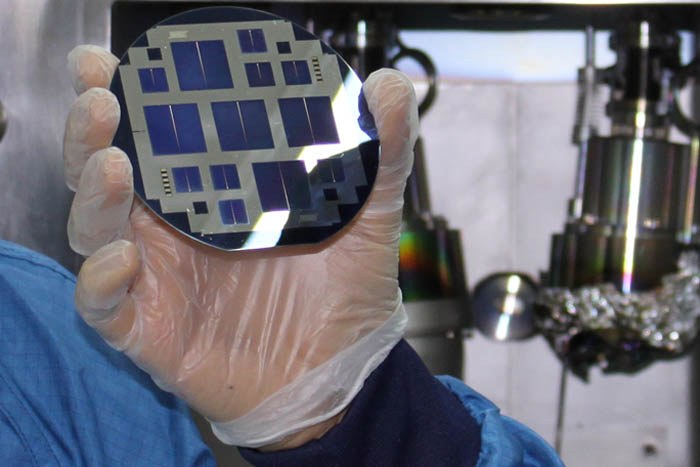High-performance photovoltaic cells
Feb 01, 2011
The Micro and Nano Technologies (MNT) research group from UPC has developed silicon solar cells that achieve a 20.5% of efficiency, so far the most efficient model existing in Spain with this material.
The cells developed by MNT have overcome the 15% barrier; on average the most common photovoltaic cells performance. Specifically, they have achieved a conversion efficiency (from sunlight to electricity) of 20.5%, which can increase by one third the energy production per surface unit. This result stands at the level of the research work carried out by international leading groups in this field.
E.g. thanks to the high performance of this new cell model, it would take only 4.8m2 of solar panels for supplying the energy consumed by a family in a year, about 4 kWh per day on average, whereas traditional cells need 6.5m2.
Composed of crystalline silicon, their operation is simple and similar to conventional cells: the light captured generates charges that are collected in the contact panel and later transformed into electricity. "The objective is to generate as many charges as possible and avoid losing them, it means, they reach the contacts," explains Ramon Alcubilla, member of the MNT research group. Finally, sunlight converted into electric current is injected into the power grid for domestic and industrial uses.
The key to success has been to minimize losses; fact that makes the silicon cells developed by UPC researchers the most efficient in Spain. "We have made considerable efforts to design and develop new materials, new structures and new technology to ensure the whole process is as perfect as possible and to reach high performance" says Alcubilla. Now the future is to develop procedures that enable the large scale manufacturing.
The result of this work - after 38 trials since 2002 - stands at the same level as other research done in leading countries in the field of photovoltaic. In fact, the maximum performance of such cells is 24.7%, achieved by an Australian research group from the University of New South Wales.
PV in the world
According to the International Energy Agency, Spain is one of the countries with the most PV installed, with more than 4,000 MW. The leader is Germany with 7,203 MW installed. Globally, according to data from the European Photovoltaic Industry, the total PV installed capacity in 2009 was 22,787 MW, 15,943 MW of which in the European Union. In fact, in two years, from 2007 to 2009, the EU has become the leader in the sector, tripling the number of PV, followed by far by Japan with 2,633 MW.
In 2010, according to the Red Eléctrica Española, home solar energy in Spain covered 2% of total electricity demand and accounts for 6.25% of the total covered by renewable resources, a category that includes the hydropower, wind, solar thermal, biomass, geothermal and energy of the seas and oceans, among others.
E.g. thanks to the high performance of this new cell model, it would take only 4.8m2 of solar panels for supplying the energy consumed by a family in a year, about 4 kWh per day on average, whereas traditional cells need 6.5m2.
Composed of crystalline silicon, their operation is simple and similar to conventional cells: the light captured generates charges that are collected in the contact panel and later transformed into electricity. "The objective is to generate as many charges as possible and avoid losing them, it means, they reach the contacts," explains Ramon Alcubilla, member of the MNT research group. Finally, sunlight converted into electric current is injected into the power grid for domestic and industrial uses.
The key to success has been to minimize losses; fact that makes the silicon cells developed by UPC researchers the most efficient in Spain. "We have made considerable efforts to design and develop new materials, new structures and new technology to ensure the whole process is as perfect as possible and to reach high performance" says Alcubilla. Now the future is to develop procedures that enable the large scale manufacturing.
The result of this work - after 38 trials since 2002 - stands at the same level as other research done in leading countries in the field of photovoltaic. In fact, the maximum performance of such cells is 24.7%, achieved by an Australian research group from the University of New South Wales.
PV in the world
According to the International Energy Agency, Spain is one of the countries with the most PV installed, with more than 4,000 MW. The leader is Germany with 7,203 MW installed. Globally, according to data from the European Photovoltaic Industry, the total PV installed capacity in 2009 was 22,787 MW, 15,943 MW of which in the European Union. In fact, in two years, from 2007 to 2009, the EU has become the leader in the sector, tripling the number of PV, followed by far by Japan with 2,633 MW.
In 2010, according to the Red Eléctrica Española, home solar energy in Spain covered 2% of total electricity demand and accounts for 6.25% of the total covered by renewable resources, a category that includes the hydropower, wind, solar thermal, biomass, geothermal and energy of the seas and oceans, among others.

Share: